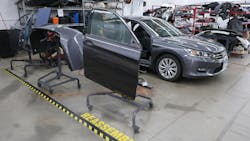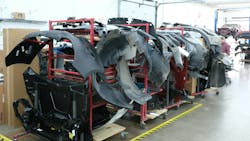In this article, we will discuss the possibility of implementing shifts in your collision repair operation. Beyond my own experience on this topic, we will be sharing the experiences of Ben Bowman of Keeler Collision, an MSO dealer repair center with shifts in their primary location in Latham, New York. We both agreed the decision to adapt shifts can be profitable, but it comes with some challenges which a “process-driven operator” can easily overcome.
Return on Investment
The benefit of implementing shifts in the collision repair industry is that the investment in the shop and equipment can be used up to 24 hours and most days of the year.
An example in a service industry is when McDonald’s decided to open their restaurants for breakfast in 1977. They now achieve 30% of their sales from that period and it secured their long-term profitability because of the gross profit they earn during the 5:00 a.m. to 11:00 a.m. time slot.
How implementing shift work might benefit an average repairer:
|
Without shifts / month |
With shifts / month |
|
|
Size of shop |
10,000 square feet |
10,000 square feet |
|
Monthly output per sq. ft. |
$25 / sq. ft. |
$40 /sq. ft. |
|
Sales |
$250,000 |
$400,000 |
|
Gross Margin |
43% |
42% (pay wage premium) |
|
Gross Profit $ |
$107,500 |
$168,000 |
|
Overhead Expenses, which incrementally grow with volume |
$45,000 (18%) |
$65,000 (16.25%) |
|
Overhead, which is generally fixed with volume (Rent, Maintenance, IT, Professional, Other) |
$48,000 (19%) |
$48,000 (12% = 7% less) |
|
Operating Profit |
$14,500 (5.8%) |
$55,000 (13.8% = 8% or approx. 140% more in the same period) |
Keeler Collision is not the average shop, though, and is able to sell $8,000,000 per year out of a 10,000 square foot location ($80 per square foot); the resulting operating profit is astounding!
It sounds easy, so why isn’t everyone doing it? The short answer is it requires you to be “process-driven.” Let’s explore the key processes to consider implementing:
Vision and Leadership
The leader of the repair center must have the vision to see that working a bit harder will yield incrementally more profit from the facility. They must be willing to enhance their processes and hire good people to make this happen. They don’t have to be the owner; they just have to be driven to do more with less. Body Shop Director Ben Bowman and his leadership team at Keeler embody that. When you ask them about shifts, their passion for finding solutions shines through.
Keeler employs a night foreman who plays an interesting role. The night foreman primarily acts as a back-end estimator who documents the repair plan on work assigned to the night shift and prepares “evidence packs” to justify their repair plan for final billing purposes. Further, they do also manage production, evaluate quality, and lead the night crew.
Technician Staffing
Staffing completes most of the same tasks that the day shift performs. Generally, the night shift team works a four-day work week and earns a 10% wage premium when working. Staffing the night shift with well-trained certified technicians who you can directly pass work to is key. Keeler employs six in the night shift. As a result, the second shift role is more appealing to the “night owl” personalities who like working these hours. As part of the orientation process, new hires work the day shift for a week to better understand the shop’s processes (to understand what and why). Keeler pays hourly based on historical performance and offers a global incentive for overall shop performance.
Repair Planning and Parts Coordination
Shifts were started at Keeler by implementing processes to remove all “question marks” during repair planning to use advanced inspections (estimates and parts receiving performed during the day) to identify, order, and receive all parts needing replacement during working hours. They use on-vehicle notes and other non-verbal communication tools (work orders, etc.) to communicate internally. All parts are received and placed on parts cart to create a fully kitted parts cart for the body repairs, regardless of the shift we are working on. When possible, parts are painted off the vehicle and transferred during repair planning to avoid bagging and tagging and to prevent unforeseen supplements during repair planning.
Passing Repairs and Work Mix
Initially, it was beneficial to earmark fast track or cosmetic work and midsized repair for the night shift. Eventually, night shift was assigned to complete heavy hits as well.
Instead of assigning jobs dedicated to night shift, we both opted to have the night crew continue the work from the day shift. A brief 30-minute overlap between shifts to review work accomplished has proven beneficial. Keeler has learned that solid documentation (highlighting the lines completed on the work order), including a periodic brief video (from night shift for the say shift) that details where they left off has further refined communication.
Production Controls / Scoreboard of Success
We quickly realized that the night crew and day shift needed to scorekeep, documenting what they accomplished versus our daily and weekly goals. Each department tracks TOTAL hours completed versus the goal, and then adjusts resources to assure level flow.
Total Labor Hours the Body Team (Body, Frame and Mechanical) Moved Upstream
|
Monday |
Tuesday |
Wednesday |
Thursday |
Friday |
|
D – 100 |
D – 120 |
D -115 |
D – 110 |
D -100 |
|
N – 35 |
N -40 |
N – 42 |
N – 50 |
N – 0 |
|
T – 135 / 150 |
T – 160 /150 |
T – 155 / 150 |
T – 160 / 150 |
T – 100 / 100 = 710 / 700 = 98% of Goal |
Total Labor Hours the Paint Team (Paint, Detail, PDR) Moved Upstream
|
Monday |
Tuesday |
Wednesday |
Thursday |
Friday |
|
D – 70 |
D – 72 |
D – 73 |
D – 75 |
D – 62 |
|
N – 30 |
N – 27 |
N - 35 |
N – 30 |
N – 0 |
|
T – 100 /100 |
T – 99 /100 |
T – 108 /100 |
T – 105 /100 |
T – 62 /75 = 474 / 475 100% of Goal |
To keep the flow level, conduct three production “huddles” per day to review the scoreboard and “read the shop floor” to see where the staffing is needed, and then to decide the sequence of work completed. These huddles should be very brief but are crucial to work to a production goal with level flow.
Mechanical or ADAS Calibration
Keeler has chosen to bring mechanical repairs in-house and doesn’t send them to the dealer mechanical department (minor exceptions). It performs calibrations in the evening on-site, if possible.
'Hospital'
Certain work either doesn’t have approval, has parts delays, or other concerns causing it not to be available to be worked on. The day shift production manager/lead should be working with the appropriate resources to remove the barriers and put it back into productive WIP.
Supplies and Materials
The creation of point-of-use carts per work area was essential. These carts are refreshed (and garbage dumped) at the end of the shift to pass a fully stocked work area to the next shift. Using the 3M RepairStack inventory management system with increased minimums and maximums ensured no stock-outs occur. Relative to stock parts, those are pulled during repair planning to ensure they are billed and to deliver a fully kitted parts cart to the technicians completing the repairs.
Security and Company Policy Updates
Late-night security is always an issue for repairers, so a security camera system which saves recordings and improving the parking area gate deters unwanted people from entering the lot. The video gives you insights on the goings-on during the night shift, when necessary. Ben’s teams share “shop tools” rather than having individual toolboxes. In our practice, we both enforced a strict “no visitor policy” overnight, as we had a few incidents which led to that policy.
Equipment Maintenance
We also realized that we needed to ensure the equipment had proper maintenance, so neither the first nor the second shift were held up by maintenance. We engaged a booth supplier who did scheduled maintenance on Friday afternoon or over the weekend so that the day shift is largely unimpacted.
Summary
In implementing shifts, our only incremental costs were a bit higher technician wage for the night crew, increased overhead staff bonuses, and some additional utility expenses. Our only capital investment was a bit more security-related costs.
Improving shop output by nearly 20-75% leads to a significant net profit percentage improvement!
Thank you, Ben Bowman, for your insights!
About the Author
Steve Trapp
Steve Trapp is an internationally known consultant and speaker. His family operates a collision repair center in Wisconsin. He earned a degree in economics education and a minor in accounting from the University of Wisconsin.
After college, he worked for 3M in sales and marketing roles with the innovative 3M ARM$ training and software sales. He worked as a consultant for AutocheX doing financial consulting for a few years before joining AkzoNobel, where he started the industry’s first value-added program. While there, he started the industry’s first paint company-sponsored 20 groups and wrote numerous training programs with third-party experts on finance, marketing, selling, leadership, and other topics.
He later joined DuPont/Axalta, where he worked with Mike Anderson to manage their 20 groups and industry seminars. While at Axalta, he managed the North American Strategic Accounts SAM team and later the entire EMEA Strategic Accounts team. He followed that as senior consultant for LEAP, a global consulting firm that has presented in 10 countries and now again works for a major paint company.


